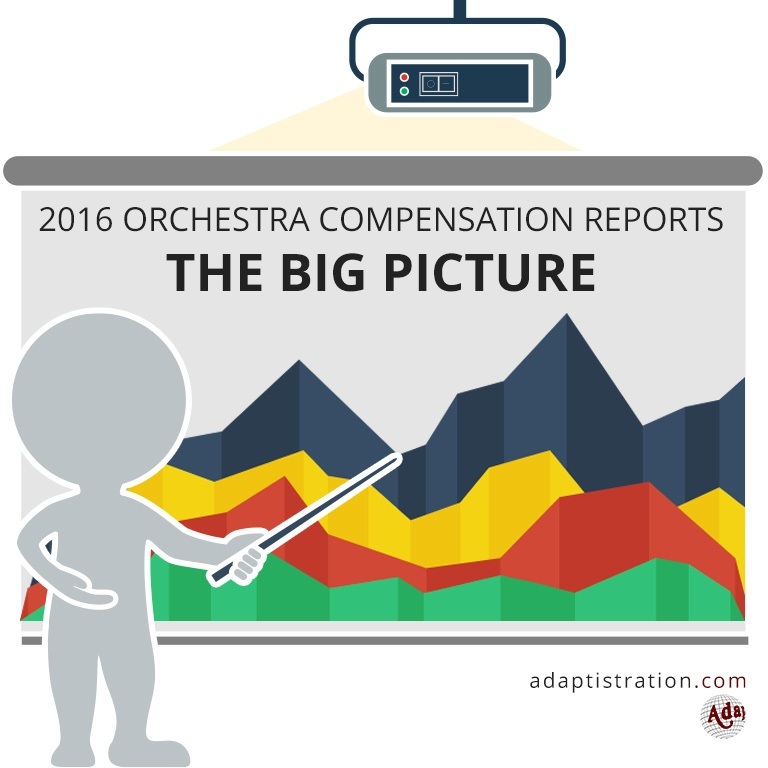The 2005/06 season was a very lucrative season for most Regional Orchestra Players Association (ROPA) music directors, on average they experienced one of the highest percentage increase in compensation over the past seven seasons…
WHERE THE NUMBERS COME FROM
In order to provide information that is as accurate as possible, data from the 2005/06 season is gathered from the following sources:
- Music Director Compensation figures were obtained from their respective orchestra’s IRS Form 990 for the 2005/06 concert season.
- Total Expenditures were also obtained from each respective orchestra’s IRS Form 990 for the 2005/06 concert season.
- Musician Base Salary figures were obtained from compensation records collected by the American Federation of Musicians (AFM) and ROPA settlement bulletins.
Adaptistration makes no claim to the accuracy of information from documents compiled or reported by external sources. If you have reason to believe any of the information is inaccurate or has changed since reported in any of the above sources and you can provide documentation to such effect, please feel free to submit a notice.
WHAT THE NUMBERS DON’T SHOW
It is important to remember that the numbers shown do not always convey a complete compensation picture. For example, a music director may have had a large increase in salary because they were leaving a position and per terms of their contract they may have received a sizeable severance or deferred compensation package. As such, the cumulative compensation may artificially inflate annual earnings. Furthermore, these figures may not reflect bonuses or other incentive payments, therefore underreporting what conductors may actually earn. Also missing from the figures are expense accounts and other perks, as such, the cumulative compensation for music directors may or may not be more than what is listed. Additionally, the documents used to gather data do not indicate how much of the season an individual received a salary. As such, excessive adjustments in the percentage change from the previous season’s compensation may be artificially adjusted.
Although the music director compensation figures include the combined amounts reported as what the IRS classifies as “compensation” and “contributions to employee benefit plans & deferred compensation,” each orchestra does not always report figures for the latter category. Additionally, some organizations list music director compensation among the five highest paid private contractors as opposed to employee compensation. In these instances, no information about benefits or deferred compensation is available.
As for ROPA musicians, unlike the vast majority of their peers in ICSOM ensembles who all earn no less than the musician base salary, all ROPA ensembles use a tiered system of salary and/or per service payments. For example, although the Richmond Symphony may list a base musician salary of $28, 837, more than 60 percent of the musicians earn less than that base salary figure. Those players are paid using the sliding per service tier system and may earn as little as a few thousand dollars per season. In the strictly per service ensembles, the figures listed in the “Base Musician” compensation column are actually the average annual income earned by section string players (or section wind players if no information for the string players was available). This figure is reported by the AFM because it best represents annual earnings for the musicians who perform the greatest number of services in any per service orchestra; string musicians. However, those compensation figures are not always guaranteed. Additionally, the “Base Musician” figures do not include any additional payments offered by some organizations such as voluntary outreach services, and minimum overscale payments. Finally, opera or ballet organizations are not included in these reports, only symphonic and chamber orchestra ensembles.
TOP 10 EARNERS
More so than executive directors, music directors are at the top of the compensation pyramid. However, unlike their administrative counterparts most conductors earn much more throughout the course of a season. Many rarely conduct more than 12 weeks at their respective ensemble; as such, they maintain regular guest conducting schedules and several even serve as resident conductors in more than one ensemble. In effect, they can easily double, triple, or even quadruple the annual compensation figures listed in this report.



